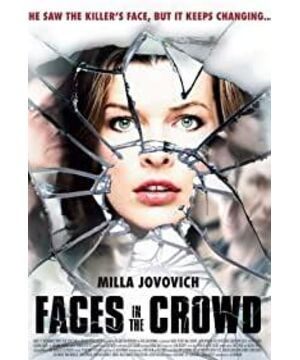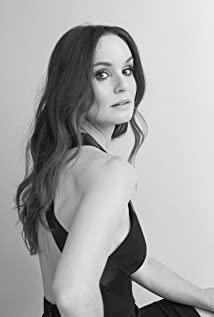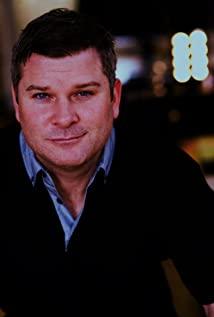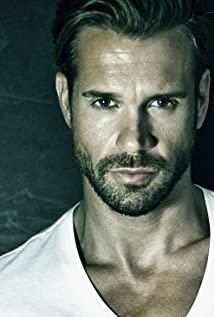The face in the crowd is officially translated as "Phantom Chasing Murder". Maybe it sounds more exciting. In fact, looking at the whole film, I prefer the former.
Anna, who was originally a kindergarten teacher, leads a peaceful life. She has a girlfriend and a boyfriend. She doesn’t like to drink champagne. She likes to observe men’s buttocks in a bar. One occasional night, she accidentally witnessed a murder and was discovered by the killer. Fortunately It was she who escaped in the killer's "killing mouth". Unfortunately, she suffered from a very rare form of face blindness. From then on, she could not distinguish anyone's face, including her own reflection in the mirror, becoming unfamiliar.
In fact, this should be a very interesting film-"face in the crowd". As we all know, the face is the most familiar and vivid biological feature of human beings. It is almost the main sign that distinguishes a person from others; and the face is an art. An important object in the creation is not only highly recognizable, but also rich in symbolic meaning. The so-called symbolic meaning means that a face is a signifier, and what it refers to is a person corresponding to this face. It is like our business card. It is socialized and stored in other people’s brain warehouses and becomes a unique symbol. The reason why I am me and he is him is because of that authoritative face. From this perspective, The human face is the main carrier of social roles and social identities. The film envisages the possibility of a semiotic framework, that is, if one day suddenly pulls away or blurs the sign of the human face, what will happen to us?
I think Anna’s panic came from this. She couldn’t identify the person she was most familiar with; the human face, this typical signifier, slipped away from where it pointed, and even the self in the mirror became unfamiliar. At that time, her own identity, sense of subjectivity, and self-signifier lost its unique certainty, and the entire society and life suddenly collapsed in front of her.
Based on this perspective, the first ten minutes of the film is quite exciting. The first is the opening shot. The camera moves irregularly on the faces of the hero and heroine, fades in and out, crosses the sleeping close-ups of the two people, and finally stops on Anna's eyes. At this time, the alarm wakes them up; very interesting. It was the dim conversation between the two people, asking each other "Hi" as if they were meeting for the first time. Bryce said, "Where have we met before?" Anna replied, "Well, it seems not." I think it's all. The most exciting passage of the film. First of all, it cuts into the human face, a special symbol that runs through all the time. The abnormal shooting and meaningful dialogue with a strong sense of form give the film enough suspense. The second appearance of the face with a sense of formality should be in the kindergarten art class. Anna’s students painted face graffiti. This is undoubtedly a kind of in-film echo of the face in the opening shot, but also a kind of Emphasis of the theme; there is a very meaningful detail, is a little girl's water glass overturned, the water stains strangely blurred the eyes of the portrait of the face, Anna watched, and a trace of ominous omen passed in her heart; that is the night , Anna had an irreversible tragedy when she came out of the bar, and she has really blurred her eyes since then.
I have to say that when the film is here, it is still a good one. The shot is special and the narration is smooth, which makes people feel like grasping the film quickly; the bright red scarf floating out of the taxi window is blood-red in Anna's night. The leather bag, clean and concise, is an expression of a strong sense of form; and the most rare thing is that the director is willing to show the climax of the film within ten minutes, that is, Anna is killed and loses the ability to recognize the face. Because if the whole movie is a narrative whole, then this arrangement breaks the narrative symbol system at the beginning, Anna is “fuzzy” from the beginning, and the last eighty minutes of the movie is a kind of “recovery” or "reconstruction". In the narrative mode of the movie, this is called "fuzzy narrative" or "destroyed narrative". It is to break something that was originally stable at the beginning of the film, and then the whole film is going back and reconstructed; this kind of "destruction at the beginning" method has left a lot of narrative space and narrative possibilities for the film; in this narrative The important thing is no longer the event itself, but the plotless performance. For example, the panic after Anna's loss of function, the nervousness of the murderer being close at hand, the weird changes in the faces of the people around, etc., will all be good directions. Unfortunately, for most of the following period, the director did not manage it well.
One of the flaws: lack of strength
The first is about the confusion of the signifier and the signifier after the face symbol is broken, which is too weak in performance.
For example, in the scene where Anna wakes up in the hospital, the lens changes from blurry to clear, and then Anna looks very confused about the people in front of her. This shot is easy to be misunderstood, because it can be a very common patient's sober shot, and it does not clearly indicate that Anna has suffered from facial blur. I think this misunderstanding lies in the lack of a rich symbolic manifestation, that is, the lack of some constant reference signs. For example, you can add some body signs to her boyfriend Bryce, the moles on the ears, and the scars on the hands are all good choices; or Bryce can repeat some fixed words, such as "Hi, we were in Have you seen it anywhere?" I believe that if there are these fixed marks as a foreshadowing, Anna will be more panic, and this panic will appear more real.
The lack of power is almost the biggest flaw in the film. In fact, many passages in the film are very good ideas, but in watching the film, it always gives people a sense of taste. It seems that it is just a click, and it does not reach the extreme. For example, Anna wakes up from a nightmare and does not recognize herself in the mirror. It is too flat and straightforward; dreams are originally a symbolic thing, especially the nightmare in this kind of film, which plays the role of replaying the story and revealing the root of horror. Might as well take the method of cross-expression, jumping repeatedly between reality and dreams, blurring their boundaries, and the film is just a canonical flashback. Then there is Anna looking in the mirror. The mirror is also a classic metaphor in the movie. It is used to express the protagonist’s observation and identification with the self, or a contrast between the appearance and the heart; for this film, it should obviously appear here. A kind of confusion; the appearance and the heart no longer match, then it should be shown on the screen, if the mirror can be blurred by the water vapor in the bathroom at this time, or Anna panicly covers the mirror with a cloth, and it will be covered by everything that can reflect light. Better; in the movie, Anna just stared in the mirror for a long time, and then sighed peacefully.
Another wasted idea is that the murderer appeared in the bar where Anna was, which is also the most important turning point of the whole film. I personally like the details of cutting the cake: it is still the big close-up like the opening of the film, the sharp knife cuts it off quickly, and the white cream cake is covered with bright red jam. This is almost the most exciting symbolic shot of the whole film. Subtly imitating the moment when the murderer cuts the woman's neck; however, such a scene did not lead to a more exciting narrative. Anna suddenly understood that the killer was just yelling when the killer was in the bar, and then fled out in panic with the people; see here It's easy to think of another movie about faces-"Vanilla Sky". There is also a similar bar scene in "Vanilla Sky". The male protagonist in the film is angry because his friends don’t recognize his face. He panicked looking in the bar. A good overhead shot was used in that movie. The mask that the male protagonist lifted above his head swayed helplessly in the crowd, which can be described as meaningful. But in this movie, it leads to the conjecture that the murderer is her boyfriend Bryce, which is really regrettable.
Mistake 2: The plot is procrastinated.
As I said before, in this kind of "destruction at the beginning" movie, what happens to the incident and the plot is not important, because the story has reached a climax in the front, what is important is that the protagonist "retraces" And the process of "reconstruction". Taking this film as an example, I personally think that the proposition of rebuilding the identification symbols should be centered on Anna, rather than unfolding too many new stories. The love between Anna and the policeman in the film is a bit abrupt. In fact, in the process of reconstruction, Anna seeks a sense of security from the policeman or from that paradise-like town. But if Anna finally fell in love with the policeman It's a bit deviated, because for Anna, what she has to do is to find a reason to continue to love when the symbol is missing and the identity is missing, instead of finding a new identity. This is obviously the opposite of "reconstructing the symbol".
Another procrastination is the appearance of the old lady doctor. A clear plot line should be drawn behind each character in the movie, so that the characters are effective; but the old lady doctor in the film appears to be a lot, if she only plays a role in treating Anna and Anna again It’s understandable to get some help from her; but in the most tense key part of the film, Anna walks side by side with the killer dressed as her boyfriend. At this time, Anna’s inner monologue turned out to be what the old lady said, "Anytime. Don't let the rhythm in your heart stop". At such a critical moment, what can be remembered and used by Anna is undoubtedly the most important powerful force. It is undoubtedly the source of all Anna's courage. Is it the unreasonable old lady who can give Anna the most power? If so, what use is the sense of security and trust the police gave Anna? Where will Anna's courage to face the chaotic life? I think there is a narrative split here. I think the most important thing is Anna herself, because Anna does not want to lose Bryce and her courage to regain life. The relationship between the old lady doctor and the police weakened this tension. If there must be someone to refer to, I think Bryce is the best choice. Bryce can act as another "mirror". He himself is Anna's best retrospector, and Anna's most unwilling life to lose. Symbol, otherwise Anna would not try to remember him by drawing a tie.
Mistake three: The overcorrection
of "face changing" Looking at the whole film, the director is still very sincere, or really wants to make this idea well; but in the specific interpretation, it is obviously a little tangible but not superficial. For example, in the film, in order to cooperate with Anna’s loss of facial recognition, the role of Boyfriend Hikari uses more than 30 people. The result of using a group of different faces to express "chaos" is obviously a bit clumsy, because it is really messy, so much so. The audience can't distinguish the characters or put most of their attention on distinguishing the characters; when it comes to "Vanilla Sky", the image of "face changing" appears many times in the film, but it is just the facial skills of the two heroines. Sex switching, when you close your eyes and kiss, it becomes A, when you open your eyes, it becomes B, when the camera hits it, it becomes A, and it becomes B when it hits back; on the contrary, it increases the horror of the film. At this point, "Faces in the Crowd" feels a bit thankless, so in many cases, the expression of art needs a bit of wisdom for white and black.
In this way, this movie is still worthy of analysis and experience. When I saw it for the third time, the name of this film review came out of my mind-One Thousand Faces. I think that many people have the same face and the face of a person who keeps changing, because they all indicate a collapse of identity and existence, so how do you find yourself in the absence of it? Perhaps the most important thing is whether you recognize a face, a unique face, or this face is your own heart, even though it may be easily submerged in thousands of people.
For movies, and for life, this may be the next topic and misfortune.
View more about Faces in the Crowd reviews











